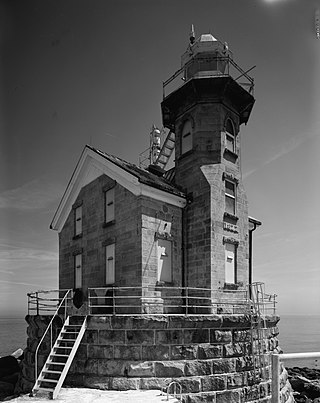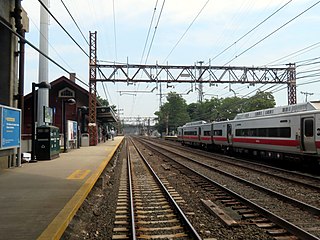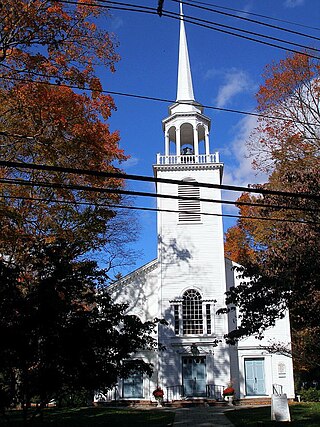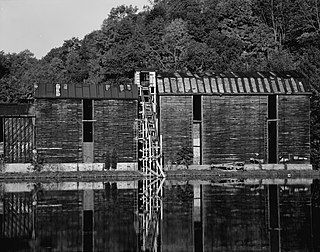
Fairfield is a town in Fairfield County, Connecticut, United States. It borders the city of Bridgeport and towns of Trumbull, Easton, Weston, and Westport along the Gold Coast of Connecticut. As of 2020 the town had a population of 61,512. The town is part of the Greater Bridgeport Planning Region.

The Merritt Parkway is a limited-access parkway in Fairfield County, Connecticut, with a small section at the northern end in New Haven County. Designed for Connecticut's Gold Coast, the parkway is known for its scenic layout, its uniquely styled signage, and the architecturally elaborate overpasses along the route. As one of the first, oldest parkways in the United States, it is designated as a National Scenic Byway and is also listed in the National Register of Historic Places. Signed as part of Route 15, it runs from the New York state line in Greenwich, where it serves as the continuation of the Hutchinson River Parkway, to Exit 54 in Milford, where the Wilbur Cross Parkway begins. Facing bitter opposition, the project took six years to build in three different sections, with the Connecticut Department of Transportation constantly requiring additional funding due to the area's high property value. The parkway was named for U.S. Congressman Schuyler Merritt. In 2010, the National Trust for Historic Preservation called the Merritt Parkway one of "America's 11 Most Endangered Historic Places".

Southport is a census-designated place (CDP) in the town of Fairfield, Connecticut. It is located along Long Island Sound between Mill River and Sasco Brook, where it borders Westport. As of the 2020 census, it had a population of 1,710. Settled in 1639, Southport center has been designated a local historic district since 1967. In 1971, it was listed on the National Register of Historic Places as the Southport Historic District.

Fairfield station is a commuter rail station on the Metro-North Railroad New Haven Line, located in Fairfield, Connecticut. The former station buildings are listed on the National Register of Historic Places as Fairfield Railroad Stations.

Greens Ledge Lighthouse is a historic offshore lighthouse in the western Long Island Sound near Norwalk, Connecticut and Darien, Connecticut. It is one of 33 sparkplug lighthouses still in existence in the United States and remains an active aid to navigation. It sits in ten feet of water on the west end of Greens Ledge, a shallow underwater reef that runs a mile west of Sheffield Island and is roughly a mile south of the entrance to Five Mile River at Rowayton. Completed in 1902 by the Philadelphia Construction Company, the cast-iron structure is approximately 90 feet tall including roughly 15 feet of the submerged caisson. In 1933, more than 30,000 tons of rocks from the excavation of Radio City Music Hall were added to the riprap foundation. The light was added to the National Register of Historic Places as Greens Ledge Lighthouse on May 29, 1990.

Penfield Reef Lighthouse is a lighthouse in Connecticut, United States, on Penfield Reef at the south side of Black Rock Harbor entrance on the Long Island Sound, off the coast of Fairfield, Connecticut. Constructed in 1874, it was one of the last offshore masonry lights. Most offshore lights built after this were cast iron towers built on cylindrical cast iron foundations.

Stratford Shoal Light, officially Stratford Shoal Light, is a lighthouse on a shoal in the middle of Long Island Sound approximately halfway between Port Jefferson, New York and Bridgeport, Connecticut.

Cos Cob station is a commuter rail stop on the Metro-North Railroad's New Haven Line, located in the Cos Cob district of Greenwich, Connecticut.

The Frederic Remington House is a historic house at 36 Oak Knoll Road in Ridgefield, Connecticut. A National Historic Landmark, it was the home of the painter and sculptor Frederic Remington (1861–1909) in the last few months of his life. Remington and his wife Eva designed the two-story gambrel-roofed, fieldstone-and-shingle house. He produced some of his finest work in the house including the sculpture The Stampede and the painting The Love Call. The house was declared a National Historic Landmark in 1965.

The Greenfield Hill Historic District encompasses the historic village area of the village of Greenfield Hill in northern Fairfield, Connecticut. The area was important from the mid-18th to 19th centuries as an intellectual center in the town, driven in part by Timothy Dwight, the Greenfield Hill Church minister and later president of Yale College. The district features a variety of architectural styles from the 18th to mid-19th century. It was listed on the U.S. National Register of Historic Places in 1971.

The Southport Historic District in the town of Fairfield, Connecticut is a 225-acre (91 ha) area historic district that was listed on the National Register of Historic Places in 1971. It preserves a portion of the modern neighborhood and former borough of Southport, Connecticut. Since the British burnt almost all of Southport's structures in 1779, there is only one home built prior to that date, the Meeker House at 824 Harbor Road, which survives.

The Wilton Center Historic District in the town center area of Wilton, Connecticut, was established as a town historic district in 1970 and was listed on the National Register of Historic Places in 1992.

Gladden Windmill is an historic windmill formerly located on Pigeon Valley Road in Napoli, Cattaraugus County, New York. The windmill was built in 1890 and is a well-preserved example of a vertical wind turbine built during the 19th century. Although no longer operational, the turbine is a rare example of wind power technology in the United States.

The Glenville School is a historic school building at 449 Pemberwick Road in the Glenville section of Greenwich, Connecticut, United States. It was listed on the National Register of Historic Places in 2003. It was one of several schools built in the town in the 1920s, when it consolidated its former rural school districts into a modern school system, with modern buildings.

The John Knap House, also known as Samuel Knap House, is a historic house at 984 Stillwater Road in Stamford, Connecticut. The house is a 2+1⁄2-story wood-frame structure, five bays wide, with a large central chimney. It was built c. 1705 by a Capt. John Knap and was owned by his son, Lt. John Knap. The house was bought from the Lt. John Knap's estate by his son Samuel Knap in 1765. It is believed to be the second oldest house in Stamford.

The Water MillMuseum is a historic water mill and local history museum located at 41 Old Mill Road, Water Mill in Suffolk County, New York, USA. It is a 2-story, heavy wood-frame structure with a wood-shingle exterior and composed of two building sections. There is a 2-story, square-shaped main section and 1-story, one-bay wing. Attached to the rear is a 2+1⁄2-story tower and 1-story glassed-in porch. The mill structure dates to the mid-17th century. It operated as a mill until the early 20th century. It is now a local museum.

The Kaatz Icehouse was a historic ice cutting facility located on the shore of Kaatz Pond, off Whitney Road in Trumbull, Connecticut. Built in 1908, it served in this role until 1955, and was believed to be one of the last surviving structures of this type in the state. It was listed on the National Register of Historic Places in 1977. Following its demolition in 1978, it was delisted in 2009.

The Cosier-Murphy House is a historic house at 67 Connecticut Route 39 in the Candlewood Corner section of New Fairfield, Connecticut. Built about 1840, it is one of the town's best-preserved 19th-century houses, and a good local example Greek Revival architecture. The house, along with a small agricultural outbuilding, was listed on the National Register of Historic Places in 1991.

The Thomas Hyatt House, also known as the Cashman House, is a Colonial style house at 11 Barlow Mountain Road in Ridgefield, Connecticut. Built about 1735, it is one of the community's oldest and best-preserved houses, retaining much of its original layout and features. It was listed on the National Register of Historic Places in 1984.

The Pine Creek Park Bridge, also known as the Mill Hill Road Bridge, is a Pratt pony truss bridge in Fairfield, Connecticut. Built in 1872, it was listed on the National Register of Historic Places in 1992. It is 54 feet (16 m) in length, and is located in conservation land on Pine Creek, having been moved there in 1979 from its original location on Mill Hill Road. It is significant as a rare example of an early iron bridge, from an era when bridge designs were changing and unsettled. It was produced by the Keystone Bridge Company of Pittsburgh, Pennsylvania, and is one of few surviving ones made by its engineer J. H. Linville.























